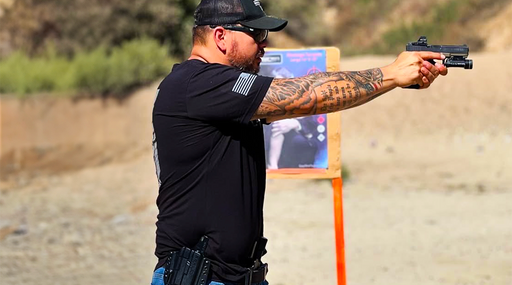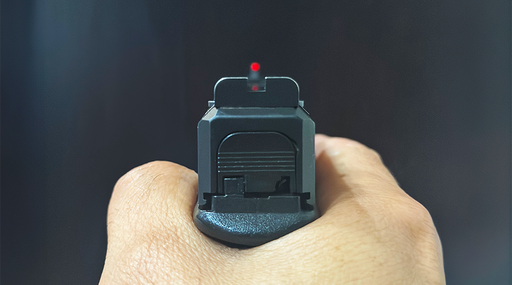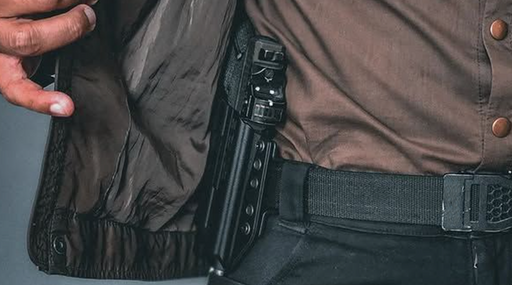It’s happened to all of us. A favorite song on the radio or running late made that right foot feel a little too heavy. Next thing you know, there are flashing blue lights in the rearview mirror.
What happens next is a subject that can stir controversy among those who carry legally. There will be some who disagree with what’s said here, so allow me to be clear about the two goals of this article. First, it aims to encourage concealed carriers, who do not count themselves among those striving to be YouTube-famous for arguing with police, to develop a new or better plan of interacting with officers during a traffic stop. As a by-product, I hope it also reduces some stress for those who patrol the highways.
The advice here assumes you understand safe gun handling and the laws of the jurisdictions where you travel. What is presented here may conflict with your state or local laws regarding firearms in a vehicle. Know before you go! Consult your state’s and/or city’s department of public safety or other resources online. A good starting point is www.handgunlaw.us
Before you start the car:
- ・Gun stowed out of sight.
- The gun should be on your person, concealed, or placed in a location where nothing can get inside the trigger guard and no unauthorized hands can touch it. Having it out of view is best for theft prevention and for preventing undue excitement by any outside observer. Ideally, you should still have access to it in that location.
- ・Legal documents secured to the driver’s side visor.
- Registration and insurance papers should be secured but ready to access on the visor.
- ・Driver’s license readily accessible.
- Whether it’s in a purse or a wallet, you’ll need quick access.
During a traffic stop:
- ・Get the driver’s license first, then the insurance/registration documents.
- Any fiddling around to get the license should be done immediately when you pull over.
- ・Front windows down.
- ・With papers in one hand, keep both hands visible to and on the steering wheel.
- Watch the officer’s approach and fully open the window on the side s/he approaches. If you don’t have power windows, roll the driver’s side window down immediately after obtaining your driver’s license and return your hands to the wheel ASAP. Keep hands open and visible to the officer(s) as much as possible.
- ・Stay in your car.
- Never get out of the car during a traffic stop unless ordered to do so. This is for your safety.
- ・Use a tone of voice that connotes respect.
- Never mind that you’re probably not pleased to have been pulled over. Be courteous, regardless of the officer’s demeanor. Being curt or rude is not productive.
- ・Know if you have a “duty to inform” an officer of your armed status.
- Know your state’s law regarding whether you must volunteer your armed status. In states where there is no duty to inform, Most people are inclined to answer that question truthfully if they are armed. However, a small percentage of officers will react negatively if you do disclose. Don’t volunteer information you don’t have to if the officer’s demeanor seems anxious or aggressive. If you’re one of those people who feels oppressive guilt for not answering the question and know in advance you’ll answer in the positive regardless of the officer’s demeanor, understand it is not uncommon to be subjected to brash questioning and potentially the request to leave your vehicle for a pat-down.
- ・If you do disclose, and the officer asks where the gun is, DO NOT REACH FOR IT.
- Take active role in your own traffic stop. It is legal in many states for an officer to take possession of the gun for the duration of the traffic stop.
- Taking possession of your gun for the duration of the stop does not require a warrant, but a search of your car or other belongings does. Even in the isolated case where a state has passes warrantless search laws, this is a violation of the Fourth Amendment. Do not argue by the roadside. If the officer is in the wrong, file a complaint and/or lawsuit later, but do not escalate into emotion on the scene. In a couple cases where an officer is nervous and disagrees with your right to self-protection, civilians have been patted down like an arrestee or even killed when a gun comes into sight. MOVE DELIBERATELY and explain your actions before you move your hands off the steering wheel.
- If the officer has inquired about a gun and it happens to be on your person, and you’re asked to step out of the car, do so, but keep hands up as you explain the location of the firearm. Do not violate firearms safety rules in the process of retrieving the firearm!
When it’s over:
- ・If your gun was in the possession of the officer during the traffic stop, re-check that it is in the condition you want it in, meaning, loaded or unloaded, safety on if it has one, hammer forward on a double-single action, and secured in its holster before setting back on the road.
- ・Evaluate your responses, whether the interaction was professional and courteous, or tense and disruptive. Could your actions or words have contributed to the interaction being less than pleasant? Did you thank the officer for doing their part for highway safety? If the interaction was clearly overreactive on an officer’s part, decide if you want to follow up with a complaint or legal action.
At the end of the day, respect is usually a two-way street. The majority of police officers understand that people who are licensed to carry are more law-abiding than the average citizen, and are supportive of your right to protect yourself and your passengers. However, stories of encountering police who come from a worldview that anyone who has a gun is a bad actor are fairly common. Have a plan and you will do just fine. As always, the best bet is to not give an officer cause to pull you over, and to have your gun and papers in order as a matter of habit, especially if you reside in a jurisdiction that conducts law enforcement checkpoints, when these interactions are almost inevitable.
Eve Flanigan is a defensive shooting and concealed carry instructor living in the American Southwest. Today she works full time as an instructor and writer in the gun industry. Flanigan loves helping new and old shooters alike to develop the skills needed to keep themselves and their loved ones safe.





















Leave a comment
1 comment
So here’s my experience with this issue from a law enforcement perspective. I’ve been an officer for over 25 years and back in the 2000’s, the law was passed in my state to conceal carry. At first I politely disarmed the drivers for my safety and theirs. There was never an issue when I did this. No complaints. Throughout the years, I relaxed my tactic because I learned CHL carriers were the least trouble makers. With the exception of one young arrogant early 20 year old who did not let me know he was carrying when I found his CHL license through a license check. Even though the law doesn’t say he had to notify, 99.9% of responsible CHL carriers did let me know. Even one front seat passenger on a traffic stop advised me he was carrying although the driver was not a CHL holder. And in that situation, the driver received a warning.